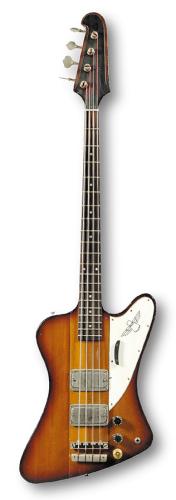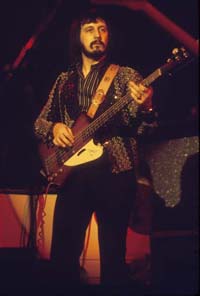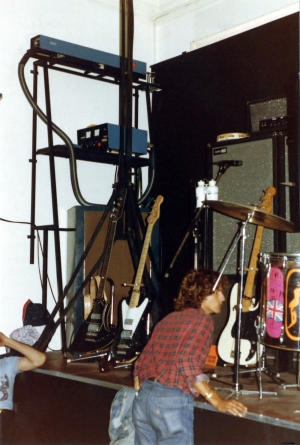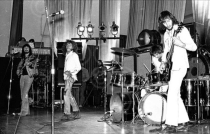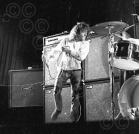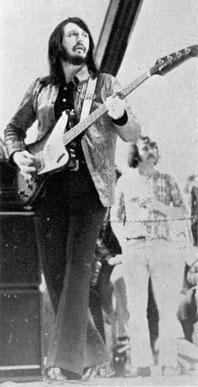John Entwistle’s Gear: 1971–1974
Overview of John Entwistle’s bass gear, from mid-1971 to 1974, with Thunderbirds and Fenderbirds, and John’s return to Sunn amps.
1971–1972
Bass guitars – 1971–1972
-
1965–69 Gibson Thunderbird IV bass (“Non-Reverse”-style)
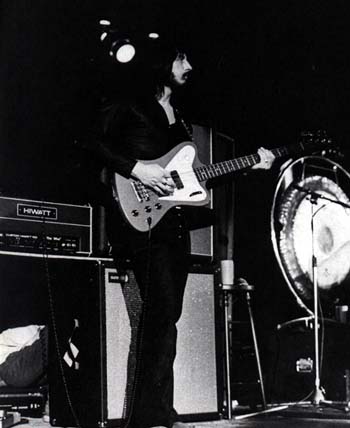
Ca. 1971, with custom-color (possibly orange) Gibson Thunderbird IV bass (“Non-Reverse”-style). Early version of Sunn rig, with Hiwatt SE4123 and Sunn 4×12 cabinets, and Hiwatt CP103 amplifier (as spare).
John began the post-Tommy era using Gibson Thunderbird IV (“Non-Reverse”-style) bass guitars in various finishes, including Sunburst and custom colour finishes.
Specs
- Honduras mahogany body in “non-reverse body” style (top bout longer than bottom bout), sunburst finish (or “Duco” nitrocellulose custom colour finishes)
- Mahogany set neck, with rosewood fretboard
- 34 3/8″ scale, 20 frets
- Chrome-plated pickup covers, bridge cover and finger rest
- Two humbucking pickups, two volume/one tone controls
- Tune-O-Matic bridge
- Laminated pickguard with finger grip and “Thunderbird” logo on top bout.
-
1964 Gibson Thunderbird IV bass
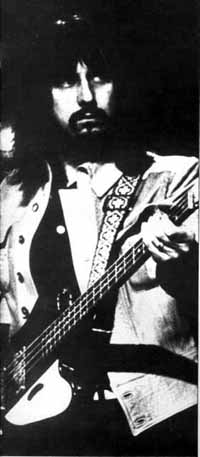
1964 Gibson Thunderbird IV bass
- Used at least two; one accidentally destroyed by Keith Moon while exiting stage at Forest Hills in July 1971, breaking the neck off; and John subsequently smashed it to pieces.
- At right, serial no. 160065 (impressed to rear of headstock), in mahogany.
- Sold in Sotheby’s May 2003 auction: estimated £6,000–£8,000; sold for £28,800.
- Owned by David Swartz.
- On display through October 2019 at the Play It Loud Exhibition at the Metropolitan Museum of Art in New York.
John: “Once you turn up the treble on a Precision, the bottom drops out.” “In big arenas, I wasn’t getting enough bottom end from the P-Basses when I had the treble all the way up.”
From April 1994 Bassist interview
“…by ‘Quadrophenia’ and Who By Numbers I was playing Gibson Thunderbirds. I felt I was getting stuck in a rut, using all the treble. So I changed to Sunn Colosseum [sic: Coliseum] power amps and a German preamp called a Stremp [sic: Stramp], and took up with the Thunderbirds. Eventually I found that I had developed a new playing style, then discovered Alembic basses and went back to playing with treble. I go backwards and forwards like that all the time.”
Specs
- Honduras mahogany body in “reverse body”-style (bottom bout longer than top bout), sunburst finish
- Mahogany through neck, with rosewood fretboard
- 34 3/8″ scale, 20 frets
- Nickel-plated pickup covers, bridge cover and finger rest
- Two humbucking pickups, two volume/one tone controls
- Tune-O-Matic bridge
- Laminated pickguard with finger grip and “Thunderbird” logo on bottom bout

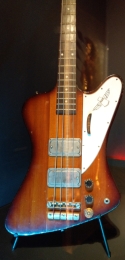
Click to view larger versions. 1964 Gibson Thunderbird serial no. 160065, collection of David Swartz.
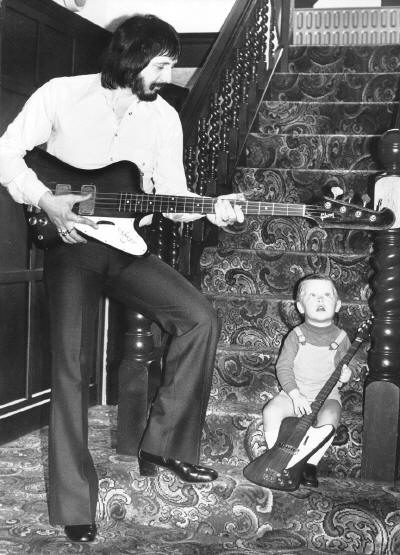
Click to view larger version. At home, with 1964 Gibson Thunderbird IV bass, and son Christopher with 1972 mini Thunderbird bass.
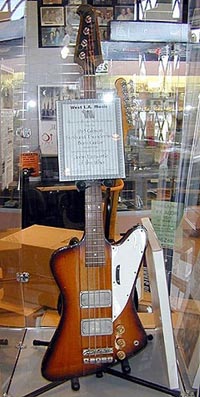
West L.A. Music has on display one of John’s 1963 Gibson Thunderbird IV basses. ©West L.A. Music.
“The Axe” Custom bass
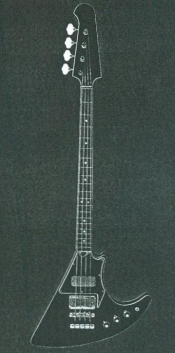
1988 Sotheby’s auction of “The Axe,” a Peter Cook custom bass built around a Gibson Thunderbird neck. Courtesy Bruce K.
- Used 15 Dec. 1971, plus Old Grey Whistle Test (1973), Tommy film (1974).
- Designed by Peter Cook from a Gibson Thunderbird-style neck, with body in the form of a pole-axe, black and cream stringing, two Thunderbird pickups, two volume and one tone control, 34″ scale.
- Inspired by previous Axe bass used 1967.
- Sold in 1988 Sotheby’s auction: estimated £2,000–3,000.
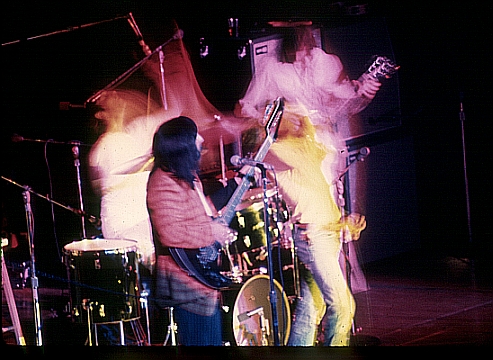
15 Dec., 1971 in Seattle, John plays “The Axe,” a Peter Cook custom bass built around a Gibson Thunderbird neck. © copyright and courtesy of Jeff Gledhill.
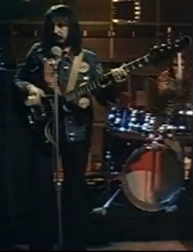
1973, Old Grey Whistle Test, John plays “The Axe,” a Peter Cook custom bass built around a Gibson Thunderbird neck.
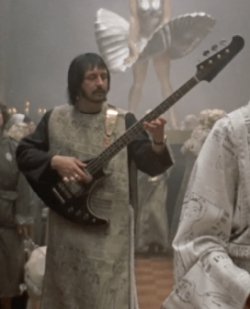
Ca. 1974, the Tommy Eyesight To The Blind scene, with “The Axe,” bass.
Amplification – 1971–1972
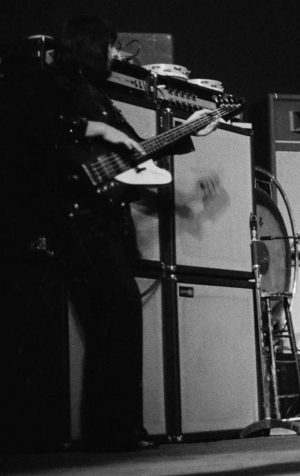
Ca. 1971, with Sunn Coliseum Bass and Sunn Coliseum Lead heads, two Sunn 4×12s and two Sunn 1×18s.
John Entwistle began using the first iteration of his Sunn rig at this time, what eventually became a 1,200-watt system, designed by Bob Heil, who also designed the Who’s first Sunn PA for the Who’s next tour. John’s rig was not miked through the PA.
1971
- Amplifiers
- One Sunn Coliseum Lead amplifer head
- One Sunn Coliseum Bass amplifer head
- Speakers
- Two Sunn 4×12 cabinets, some fitted with Bob Heil’s Ye Old Music Shop of Marissa, Illinois, badges; or one Sunn 4×12 with one Hiwatt SE4123 4×12 cabinet
- Two Sunn 1×18 cabinets
At the Oval Kennington, 18 Sept. 1971, an additional Coliseum Bass amp was used. But John largely remained with the one Coliseum Lead/one Coliseum Bass each on one Sunn 4×12/1×18 stack through December 1971.
Conrad Sundholm (of Sunn), on the Sunn Coliseum bass amp (from the Sunn Shack (archived):
But the Coliseum series, that included the bass amp used by the Who, was a unique preamp circuit because each of the tone controls was a separate preamp. You could turn it all the way off, so you had ultimate control. A lot of versatility — you could turn the midrange off or turn the bass off or the treble, it used active filters.
1972
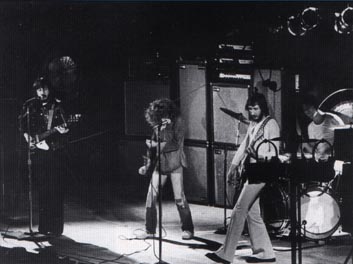
23 Aug. 1972, Kungliga tennishallen, Stockholm, Sweden, Sunn rig, with one Sunn Coliseum Bass (top), one Sunn Coliseum 880 (middle), and one Sunn Coliseum Lead (bottom). Bass is 1964 Gibson Thunderbird IV.
When the Who returned to the road in August 1972 for the European tour, John had expanded the Sunn rig, adding a Sunn Coliseum 880 amplifier head, and two Sunn 3×12 cabinets sitting at either side of the setup on top of the 1×18 cabinets, and were fitted with badges from Bob Heil’s Ye Old Music Shop of Marissa, Illinois. This configuration remained through the 10 March, 1973, Voorburg one-off show, and August 1973 rehearsals.
- Amplifiers
- One Sunn Coliseum Lead amplifer head
- One Sunn Coliseum 880 amplifer head
- One Sunn Coliseum Bass amplifer head
- Speakers
- Two Sunn 4×12 cabinets (center)
- Two Sunn 1×18 cabinets (left/right bottom)
- Two Sunn 3×12 cabinets (left/right top), fitted with Bob Heil’s Ye Old Music Shop of Marissa, Illinois, badges.
Sunn Coliseum amplifier (silver model) specs
Sunn Coliseum 880

Generic Sunn Coliseum 880.
- Front panel:
- two inputs, brite switch, volume, low bass (20–80hz), hi bass (80–250hz), mid (250hz–1khz), treble (1–10khz), range switches on mid and treble controls, distort, sustain, distort on/off switch, polarity switch, power switch.
- Rear panel:
- circuit breaker, two speaker jacks, footswitch jack for distort/boost, preamp out jack, mixer input jack.
- Power:
- 320 watts RMS (880 watts peak).
- Dimensions:
- 30″ wide, 6½″ tall, 11½″ deep. 40 lbs.
Sunn Coliseum Lead

Generic Sunn Coliseum Lead.
- Front panel:
- Channel 1: two inputs, norm/brite switch, volume, low bass (20–80hz), hi bass (80–250hz), mid (250hz–1khz), treble (1–10khz), tone range switches on mid and treble controls.
Channel 2: two inputs, norm/brite switch, volume, low bass (20–80hz), hi bass (80–250hz), mid (250hz–1khz), treble (1–10khz), tone range switches on mid and treble controls, reverb, rate, depth.
polarity switch, power switch. - Rear panel:
- circuit breaker, footswitch jack, two speaker jacks, preamp out jack, mixer input jack.
- Power:
- 320 watts RMS (880 watts peak); 220 watts at 4 ohms, 320 watts at 2 ohms.
Sunn Coliseum Bass

Generic Sunn Coliseum Bass.
- Front panel:
- Two inputs, Norm/Brite switch, volume, lo bass (20-80hz), hi bass (80–250hz), mid (250hz–1Khz), treble (1–10Khz); tone range switches on mid and treble controls, polarity switch, power switch.
- Rear panel:
- Circuit breaker, two speaker jacks, preamp out jack, mixer input jack.
- Power:
- solid state, 320 RMS (880 watts peak) watts at two ohms and was built to power a pair of 1×18″ bass reflex cabinets
Sunn Coliseum Slave

Generic Sunn Coliseum Slave.
- Front panel:
- Line in jack/line out jack, input sensitivity (off/.5volt/1volt/2volt), audio/117v switch, lighted VU meter, polarity switch, power switch.
- Rear panel:
- Circuit breaker, two speaker jacks, preamp out jack, mixer input jack.
- Power:
- solid state, 320 RMS (880 watts peak) in a 2ohm load.
- Dimensions:
- 30″ wide, 6½″ tall, 11½″ deep. 50 lbs.
Selected quotes from John Entwistle
All quotes and references are copyright their original owners and are included for reference only.
From December 1996 Total Guitar magazine interview
- What gear were you using on the [Quadrophenia] sessions?
“It was a Gibson Thunderbird bass and Sunn amps. I used a very straight bass sound in the studio, although later for the tours I started to use more treble and got a bit raunchier. But I basically set the Sunn amps completely flat. I’ve never been fully comfortable with my bass sound, and it doesn’t seem to transfer to tape very well unless it’s live. I felt like I’d got stuck in a rut and the only way I could get out of it was by changing my playing style, my technique and all my gear. I started using the Thunderbird which had a much bassier sound, in fact no treble at all!
Sunn amps had a pretty solid sound to them and all this combined helped me out of this rut I was in as a player. I then went back to using treble and my style changed yet again. Even now, when I find myself in a corner, I force myself to change equipment or play in a different way.”
From October 1994, Guitar World interview
Also, around Quadrophenia was when I changed to Gibson Thunderbird basses. Either Thunderbird or Fender/Thunderbird hybrids. I had bodies made with the Thunderbird pickup and bridge. The bridge is positioned a sixteenth of an inch forward of where it is on the stock Thunderbird. And I put Fender necks on because the Thunderbird necks were too thin on top.
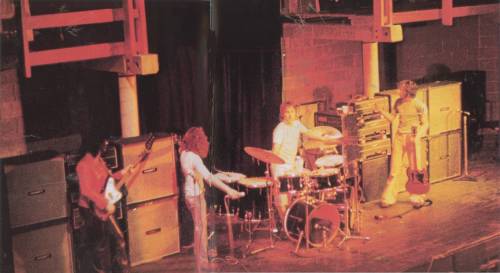
Ca. Spring 1971, Young Vic, with last uses of the Hiwatt rig, and first uses of the 1965–69 sunburst Gibson Thunderbird IV (“Non-Reverse”-style).
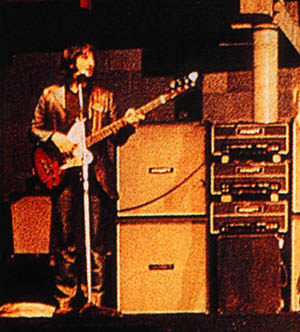
Ca. Spring 1971, Young Vic, with last uses of the Hiwatt rig, and first uses of the 1965–69 sunburst Gibson Thunderbird IV (“Non-Reverse”-style).
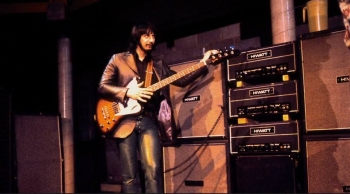
Click to view larger version. Ca. Spring 1971, Young Vic, with last uses of the Hiwatt rig, and first uses of the 1965–69 sunburst Gibson Thunderbird IV (“Non-Reverse”-style). Marshall PA cab visible at left.

Ca. 1971, with custom-color (possibly orange) Gibson Thunderbird IV bass (“Non-Reverse”-style). Early version of Sunn rig, with Hiwatt SE4123 and Sunn 4×12 cabinets, and Hiwatt CP103 amplifier (as spare).
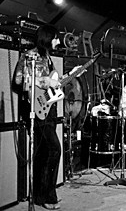
Ca. 1971, with custom-color (possibly orange) Gibson Thunderbird IV bass (“Non-Reverse”-style). Amp rig is Sunn Coliseum Bass and Sunn Coliseum Lead heads, two Sunn 4×12s and two Sunn 1×18s.
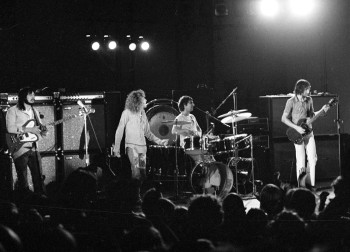
Click to view larger version. 16 Aug. 1971, Southern Illinois University, Edwardsville, Ill., with custom-color (possibly orange) Gibson Thunderbird IV bass (“Non-Reverse”-style). Possibly the bass Keith tripped over and broke the neck off of it. Amp rig is one Sunn Coliseum Bass head (left) and one Sunn Coliseum Lead head (right), with two Sunn 4×12s and two Sunn 1×18s. Courtesy Bob Elliott.
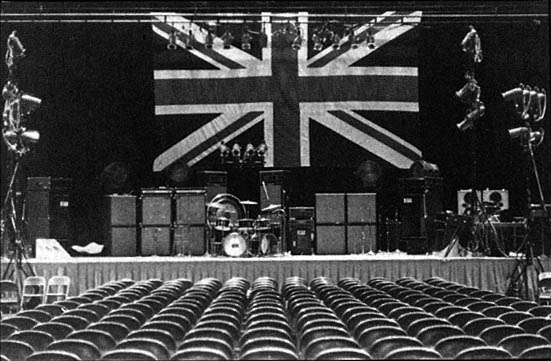
Ca. December 1971 stage setup, showing John’s Sunn setup, with Sunn Coliseum Bass and Sunn Coliseum Lead heads, two Sunn 4×12s and two Sunn 1×18s. Stack stage-right of John’s rig is for guitar monitoring.
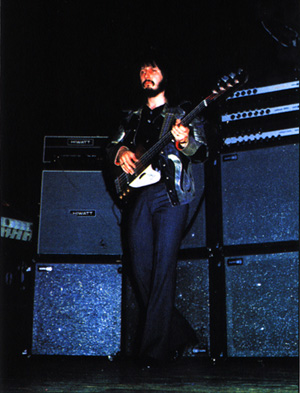
21 Aug. 1972, Kb-Hallen, Denmark, showing Hiwatt/Sunn “foldback” stack topped by Hiwatt CP103 next to John’s rig, for monitoring guitar signal. Portion of rear panel of lighting control board visible at far left.

23 Aug. 1972, Sunn rig, with one Sunn Coliseum Bass (top), one Sunn Coliseum 880 (middle), and one Sunn Coliseum Lead (bottom). Bass is 1964 Gibson Thunderbird IV.
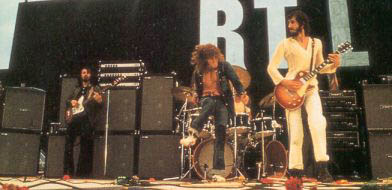
9 Sept., 1972, showing the Sunn rig, with one Sunn Coliseum Bass (top); one Sunn Coliseum 880 (middle); and one Sunn Coliseum Lead (bottom). Cabinets are two Sunn 3×12 (outside top, fitted with Ye Old Music Shop of Marissa, Illinois, badges); two Sunn 4×12 (inside); and two Sunn 1×18 (outside bottom). At far left, Hiwatt/Sunn “foldback” stack topped by Hiwatt CP103 next to John’s rig, for monitoring guitar signal. Bass is 1965–69 sunburst Gibson Thunderbird IV (“Non-Reverse”-style).
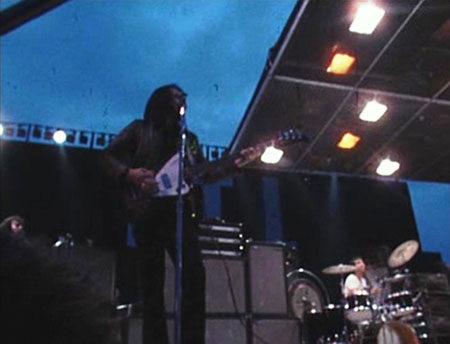
9 Sept., 1972, showing the Sunn rig, with one Sunn Coliseum Bass (top); one Sunn Coliseum 880 (middle); and one Sunn Coliseum Lead (bottom). Cabinets are two Sunn 3×12 (outside top, fitted with Ye Old Music Shop of Marissa, Illinois, badges); two Sunn 4×12 (inside); and two Sunn 1×18 (outside bottom). Bass is 1965–69 sunburst Gibson Thunderbird IV (“Non-Reverse”-style).
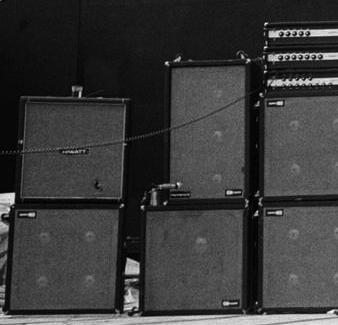
9 Sept., 1972, detail of the Sunn rig, with one Sunn Coliseum Bass (top); one Sunn Coliseum 880 (middle); and one Sunn Coliseum Lead (bottom). Cabinets are two Sunn 3×12 (outside top, fitted with Ye Old Music Shop of Marissa, Illinois, badges); two Sunn 4×12 (inside); and two Sunn 1×18 (outside bottom). At far left, Hiwatt/Sunn “foldback” stack topped by Hiwatt CP103 next to John’s rig, for monitoring guitar signal.
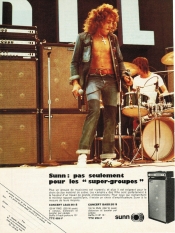
Click to view larger version. 1970s Sunn Who ad in French: “Not just for Super-Groups.” Photo taken 9 Sept., 1972, with detail of the Sunn rig.
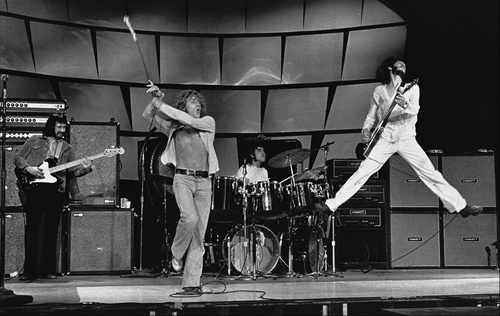
Ca. August 1973, rehearsals.
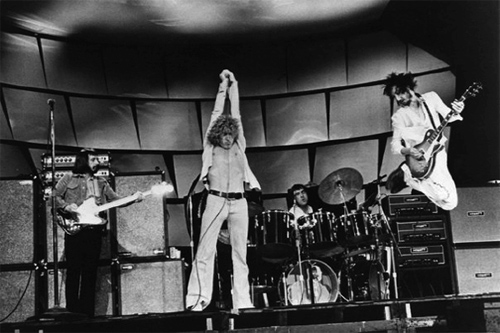
Ca. August 1973, rehearsals.
1973–1974
Bass guitars – 1973–1974
- 1964 Gibson Thunderbird IV bass (as above)
-
“Fenderbird”
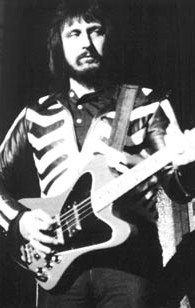
“Fenderbird”
Sunburst, black and orange/red-painted “Fenderbird” basses, made by luthier Peter Cook.
- Gibson Thunderbird bridge hardware and electronics.
- Custom mahogany Thunderbird IV-clone bodies (slightly thicker than a standard Thunderbird IV body to accept the Fender bolt-on neck — possibly the same thickness as a Fender Precision; which improved the tone, according to John).
- Fender Precision maple neck, bolted on.
- Height adjustment screws on the pickups were altered by Peter Cook to be slightly countersunk so John didn’t tear his fingernails on them.
- Paxman cases specifically designed for the Fenderbirds.
Peter Cook made approximately six of these bass guitars for John.
“Fenderbird” details
Multiple views of one of John Entwistle’s orange/red-painted “Fenderbird” custom bass guitars and Paxman case, courtesy Rock Stars Guitars.
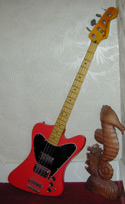
Click to view larger version: Front view of John Entwistle’s “Fenderbird,” courtesy Rock Stars Guitars.
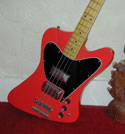
Click to view larger version: Body view of John Entwistle’s “Fenderbird,” courtesy Rock Stars Guitars.
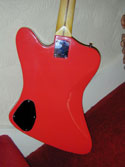
Click to view larger version: Rear view of John Entwistle’s “Fenderbird,” courtesy Rock Stars Guitars.
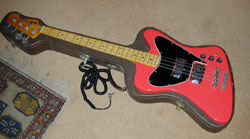
Click to view larger version: Top view of John Entwistle’s “Fenderbird” and custom Paxman case, courtesy Rock Stars Guitars.
-
1967 Rickenbacker 4005L “Light Show” bass
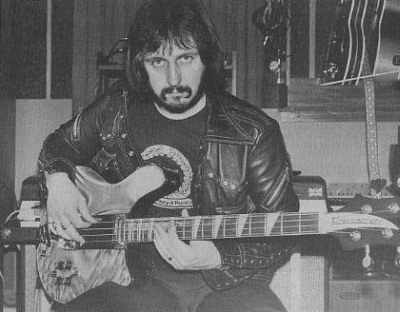
John with Rickenbacker 4005L “Light Show” bass.
- Serial no. GE2208
- Used with the Who for television appearance only (5:15 rehearsal on 3 Oct. 1973, on “Top of the Pops”)
Amplification – 1973–1974
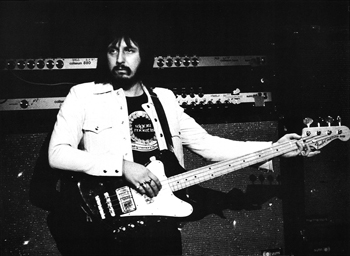
Click to view larger version. Detail of Sunn rig, with setting markings. Amps are: (left top) Sunn Coliseum 880; (left bottom) Sunn Coliseum Slave; (right top) Sunn Coliseum Bass; (right bottom) Sunn Coliseum Lead.
For the Quadrophenia shows starting October 1973, John expanded the Sunn rig further, adding a Coliseum Slave power amp and Sunn W 1×18 bins in the center of the stack configuration. This setup was used through May 1974, and a slightly modified setup was used for the June 1974 Madison Square Garden run, with two Coliseum Bass amplifiers stacked on one Coliseum Lead, with the Coliseum Slave set to the side on top of a 1×18 cabinet.
October 1973 – May 1974
- Amplifiers
- One Sunn Coliseum Lead amplifier head
- One Sunn Coliseum Slave power amp (connected to Lead)
- One Sunn Coliseum 880 amplifier head (for midrange)
- One Sunn Coliseum Bass amplifier head (connected by preamp out of 880)
- Speakers
- Two Sunn 4×12 cabinets (center left/right)
- Driven by Coliseum 880
- Two Sunn 3×12 cabinets (top outside left/right), fitted with Bob Heil’s Ye Old Music Shop of Marissa, Illinois, badges.
- Driven by Coliseum Bass
- Two Sunn 1×18 cabinets (bottom outside left/right) (with Cerwin-Vega speakers)
- Driven by Coliseum Lead/Slave
- Two Sunn W 1×18 PA bins (bottom inside left/right)
- Driven by Coliseum Lead/Slave
- Two Sunn 4×12 cabinets (center left/right)
- Signal divided by electronic crossover and sent to particular amplifier set for frequency range.
June 1974
- Amplifiers
- One Sunn Coliseum Lead amplifier head
- Two Sunn Coliseum Bass amplifier heads
- One Sunn Coliseum Slave power amp
- Speakers
- Two Sunn 4×12 cabinets (top center/top outside stage left)
- Two Sunn 3×12 cabinets (top outside left/right)
- Two Sunn 1×18 cabinets (bottom outside left/right) (with Cerwin-Vega speakers)
- Two Sunn W 1×18 PA bins (bottom inside left/right)
- Signal divided by electronic crossover and sent to particular amplifier set for frequency range.
Selected quotes from John Entwistle
All quotes and references are copyright their original owners and are included for reference only.
From October 1994, Guitar World interview
Also, around Quadrophenia was when I changed to Gibson Thunderbird basses. Either Thunderbird or Fender/Thunderbird hybrids. I had bodies made with the Thunderbird pickup and bridge. The bridge is positioned a sixteenth of an inch forward of where it is on the stock Thunderbird. And I put Fender necks on because the Thunderbird necks were too thin on top.
From November 1975, Guitar Player interview
Once I realized the Thunderbird was the bass I was going to be playing for a few years, I panicked because they stopped making them. I went to Manny’s [156 West 48th St., New York, NY 10036], and told them to buy up the whole stock, so consequently I got ten two-pickup Thunderbirds. Some of them had harmonic, microphonic pickups, so I couldn’t use them, and with the rest, I just couldn’t get the action as low as I wanted. So I used the pickups and hardware and bought some blonde Fender Precision necks and had some old style Thunderbird bodies built for the Fender necks to fit, and I’ve been using them on stage more than the Thunderbirds. I use them for recording as well. Blonde Precision necks are my favorites; those and Rickenbackers. Thunderbird necks tend to be too thin down at the bottom. I get my fingers all tangled up when I go to the first fret.
From November 1975, Guitar Player interview
On stage, I use two Sunn Coliseum stacks with Ox, and four with the Who. I use the straight Coliseum amp with a slave going through four 18’s, two in a big reflex cabinet, almost like a PA cabinet, and two in just straight compressed cabinets. Then I use two other amps, one for midrange, going through two 4-12’s and then an amp coming from the preamp out into the front of the next amp, with a lead cord which goes through two 3-12’s, which are like PA cabinets as well. This so I can project the sound but still have some sound on stage. The 18’s are Vegas and the 12’s are all the normal Sunn speakers.
- What setting do you use on the amps?
I more or less have to use the equipment flat out with the stuff I’m using with Ox. I’d much rather use a lot more equipment, but it means I’d probably drown the band completely out. To get more treble I use an MXR, the little red box. It has a reverse limiting effect; it spreads the sound out and sustains it. It also doubles the volume. The only other pedal I use is a phaser, though I have quite a few other pedals at home — Morley echo pedals, power-wahs — but I really haven’t had time to incorporate them. I don’t want big rows of switches all over the place; I trip over the phaser as it is.
From the October 1974 Guitarist:
From about the time of the Who’s next album I used a cross between a Gibson Thunderbird and a Precision. I had it made for me with a Fender neck and the Thunderbird body, with Gibson bridge and fittings. Now I’m back to Precisions, but I’m happy with anything really, as long as it’s long-scale. I need to have the right feel when I’m on stage, and short-scale basses just don’t feel right for me.
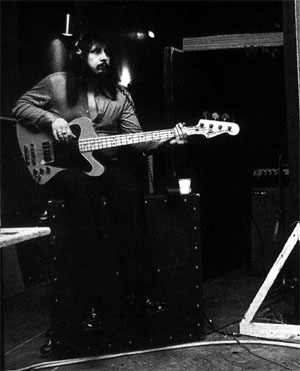
Ca. 1973, Ramport Studios, recording Quadrophenia, with Orange-painted “Fenderbird,” and Sunn amp/cab (background).
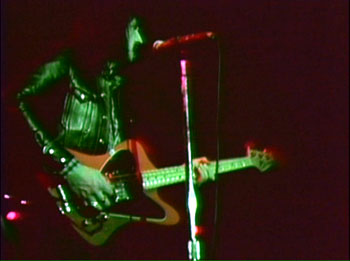
Orange-painted “Fenderbird,” ca. March 1973.
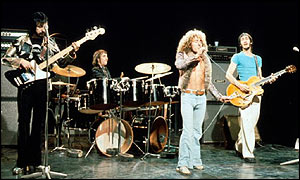
Performing 5.15 on “Top of the Pops,” 3 Oct. 1973, with “Fenderbird” in black.
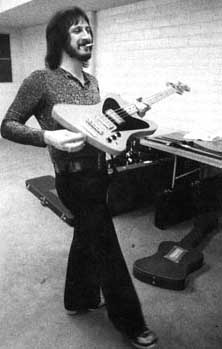
Painted “Fenderbird,” with custom Paxman case viewable below table.
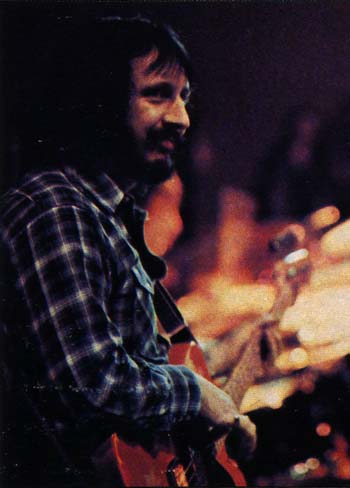
Ca. 1973, painted “Fenderbird”
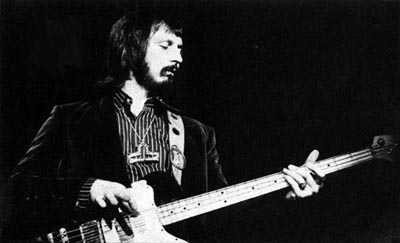
Black finish “Fenderbird”
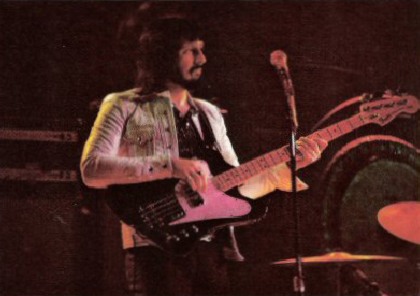
Black finish “Fenderbird”
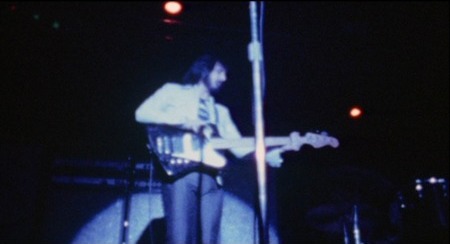
Black finish “Fenderbird”
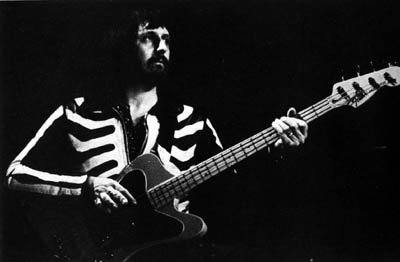
Orange-coloured “Fenderbird”
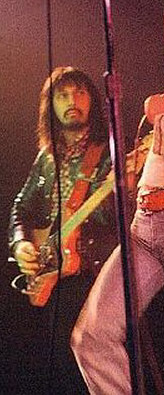
Orange-coloured “Fenderbird”
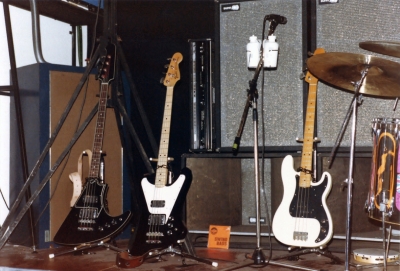
Click to view larger version. From the 1978 Who Exhibition in London, a “Fenderbird” bass, centre (with the “Axe” bass and a Fender Slab bass), in front of a Sunn stack of 3×12 cabinets and 1×18 bins and back panel of Sunn amplifier.
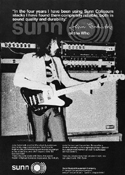
Click to view larger version. Black-finish “Fenderbird” and Sunn stack pictured in Sunn ad, ca. 1974. Courtesy WhiteFang’s Who Site.
Amplification
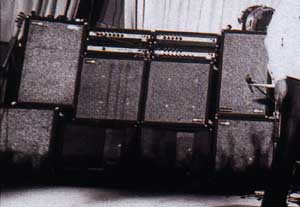
Sunn rig, ca. October 1973. Amps are: (left top) Sunn Coliseum 880; (left bottom) Sunn Coliseum Slave; (right top) Sunn Coliseum Bass; (right bottom) Sunn Coliseum Lead. Cabinets are two Sunn 3×12 (outside top); two Sunn 4×12 (inside top); two Sunn 1×18 (outside bottom); and two Sunn W 1×18 bins (inside bottom).
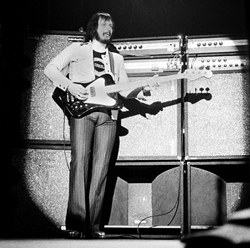
Click to view larger version. 11 Nov. 1973, detail of Sunn rig. Amps are: (left top) Sunn Coliseum 880; (left bottom) Sunn Coliseum Slave; (right top) Sunn Coliseum Bass; (right bottom) Sunn Coliseum Lead. Cabinets are Sunn 3×12 (outside top); two Sunn 4×12 (inside top); Sunn 1×18 (outside bottom); and two Sunn W 1×18 bins (inside bottom).
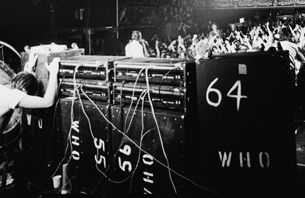
Click to view larger version. Ca. November 1973, the Lyceum, London, Rear view of Sunn rig. Amps are: (right top) Sunn Coliseum 880; (right bottom) Sunn Coliseum Slave; (left top) Sunn Coliseum Bass; (left bottom) Sunn Coliseum Lead. Cabinets are two Sunn 3×12 (outside top); two Sunn 4×12 (inside top); two Sunn 1×18 (outside bottom); and two Sunn W 1×18 bins (inside bottom).
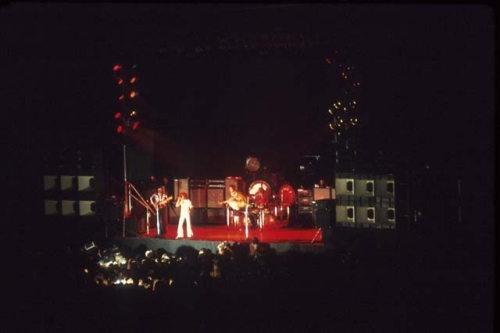
20 Nov. 1973, at the Cow Palace, San Francisco, with Sunn rig configuration.
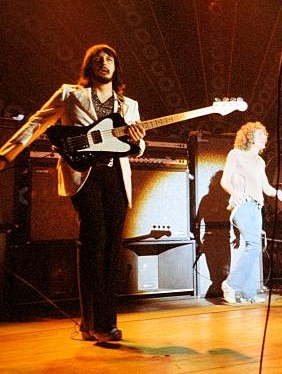
Ca. December 1973, Edmonton, Sunn rig configuration.
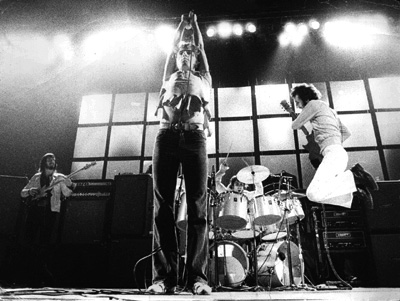
Ca. 1974, Sunn rig configuration.
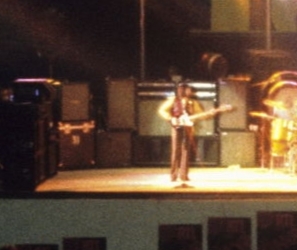
10 Feb. 1974, Parc des Expositions, Paris, Sunn rig configuration.
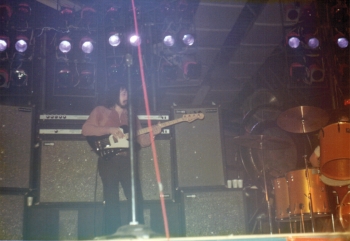
Click to view larger version. 22 Feb. 1974, Parc des Expositions, Nancy, France, Sunn rig configuration.
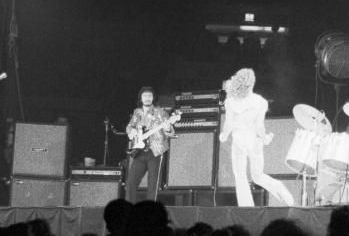
Ca. June 1974 at Madison Square Garden, Sunn rig configuration. Amps are: (center top) Sunn Coliseum Bass (x2); (center bottom) Sunn Coliseum Lead; (left) Sunn Coliseum Slave. Cabinets are two Sunn 3×12 (center outside top); Sunn 4×12 (inside top and right top); two Sunn 1×18 (outside bottom); and two Sunn W 1×18 bins (inside bottom). Hiwatt/Sunn 4×12 stack at far left is for guitar monitoring. Photo courtesy and © Mike Landskroner.
Resources and Information
Contributors
Thanks to those who have made this page possible:
- Paul Winkler (pw_lists@slinkp.com)
- Brad Rodgers (whocollection.com)
- Rock Stars Guitars, rockstarsguitars.com
Additional Information:
- Brad Rodgers at whocollection.com
- Rock Stars Guitars, rockstarsguitars.com
- Sotheby’s May 2003 auction: sothebys.com
- Dr. Tube’s Schematics: drtube.com/guitamp.htm
- PlexiPalace Vintage Amps Forum: vintageamps.com/plexiboard/viewforum.php?f=3 (archived)
- Unofficial Sunn Equipment: sunn.ampage.org/site/museum/ (archived)
- Includes “museum,” schematics and history.
- The Sunn Shack: richbriere.com/The_Sunn_Shack.htm (archived)
- Bass Culture, by John Entwistle; forewords by Roger Daltrey and Rick Nielsen. Published 2004 by Sanctuary Publishing
- Vintage Guitars Info: guitarhq.com/gibson.html
- Vintage Guitars Info: guitarhq.com/fender2.html#pbass
- Fly Guitars Gibson Thunderbird bass: flyguitars.com/gibson/bass/Thunderbird.php
- 2011 interview with John Entwistle’s luthier/guitar maker Peter Cook posted on flatericbassandguitar.blogspot.com
Manufacturer’s Sites
- Rotosound Strings: rotosound.com
- Gibson USA: gibson.com
- Sunn Amplification: sunnamps.com
